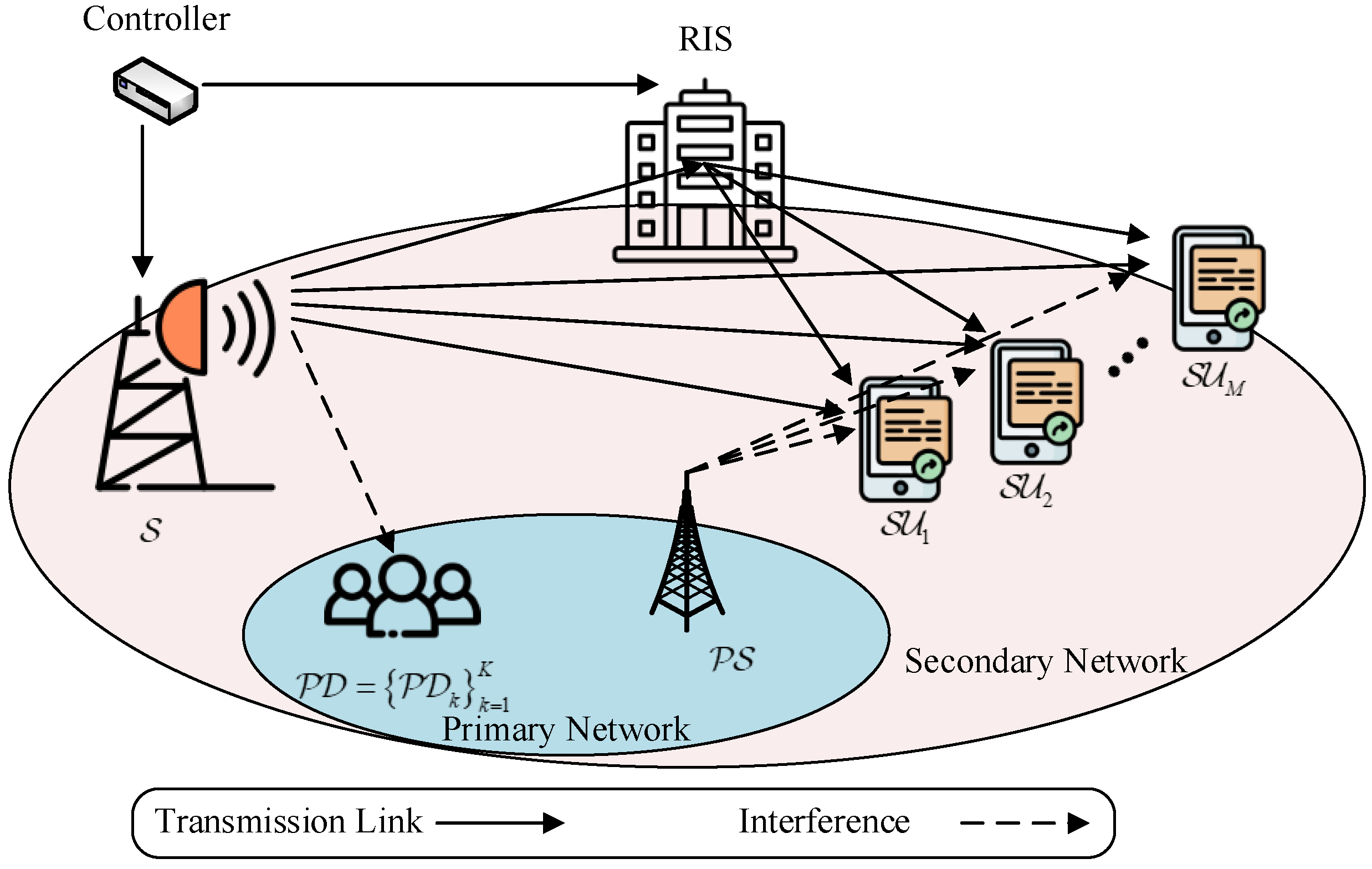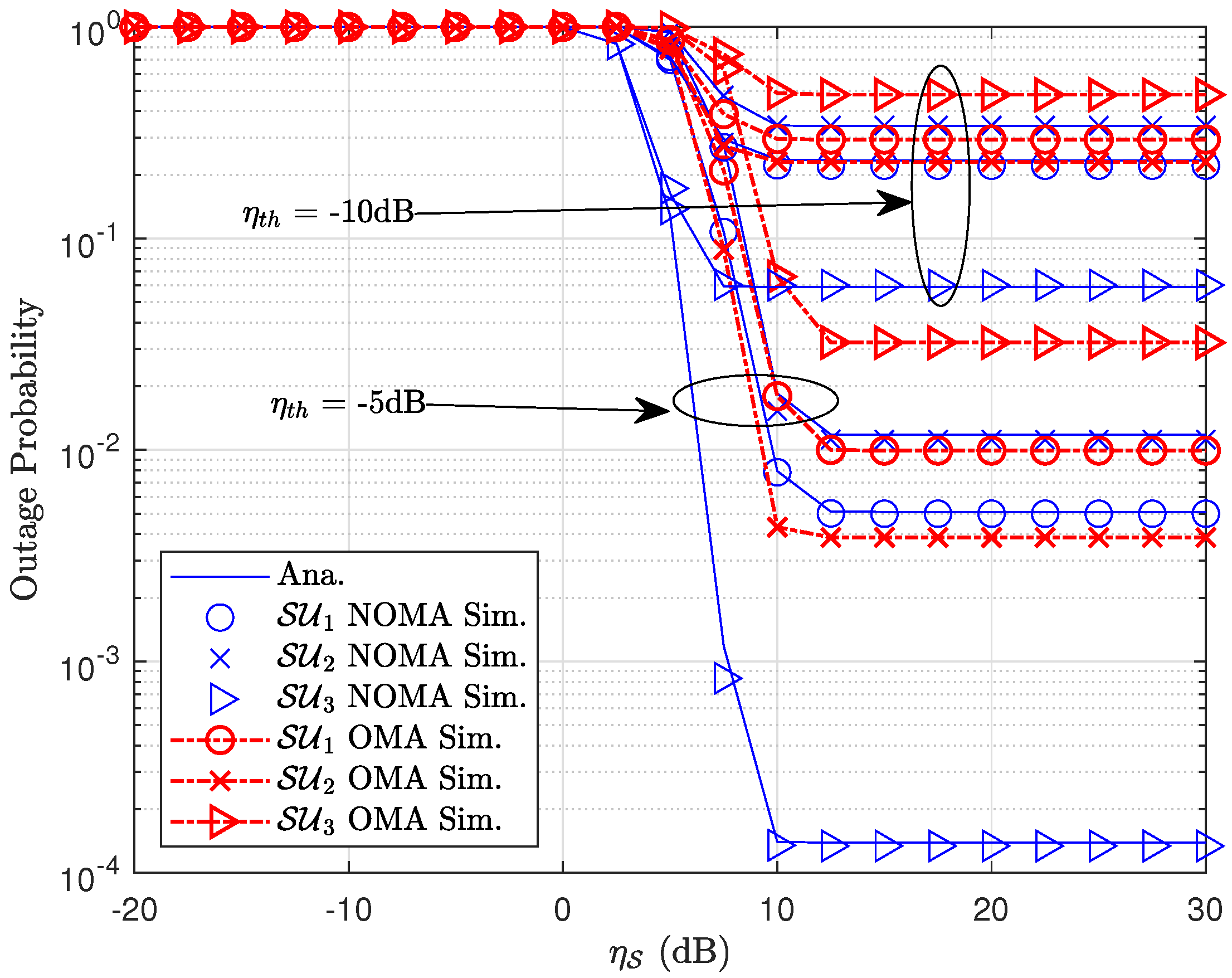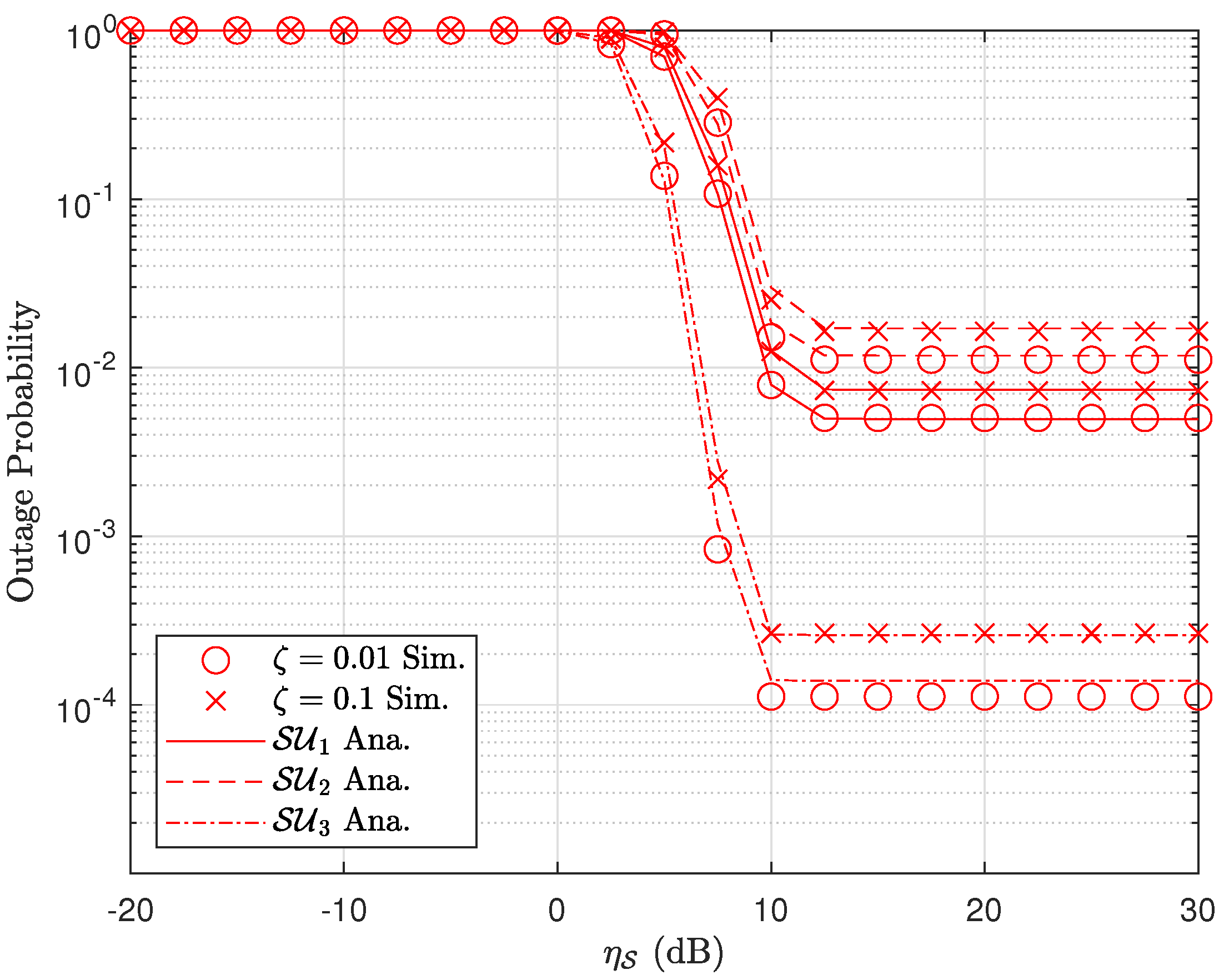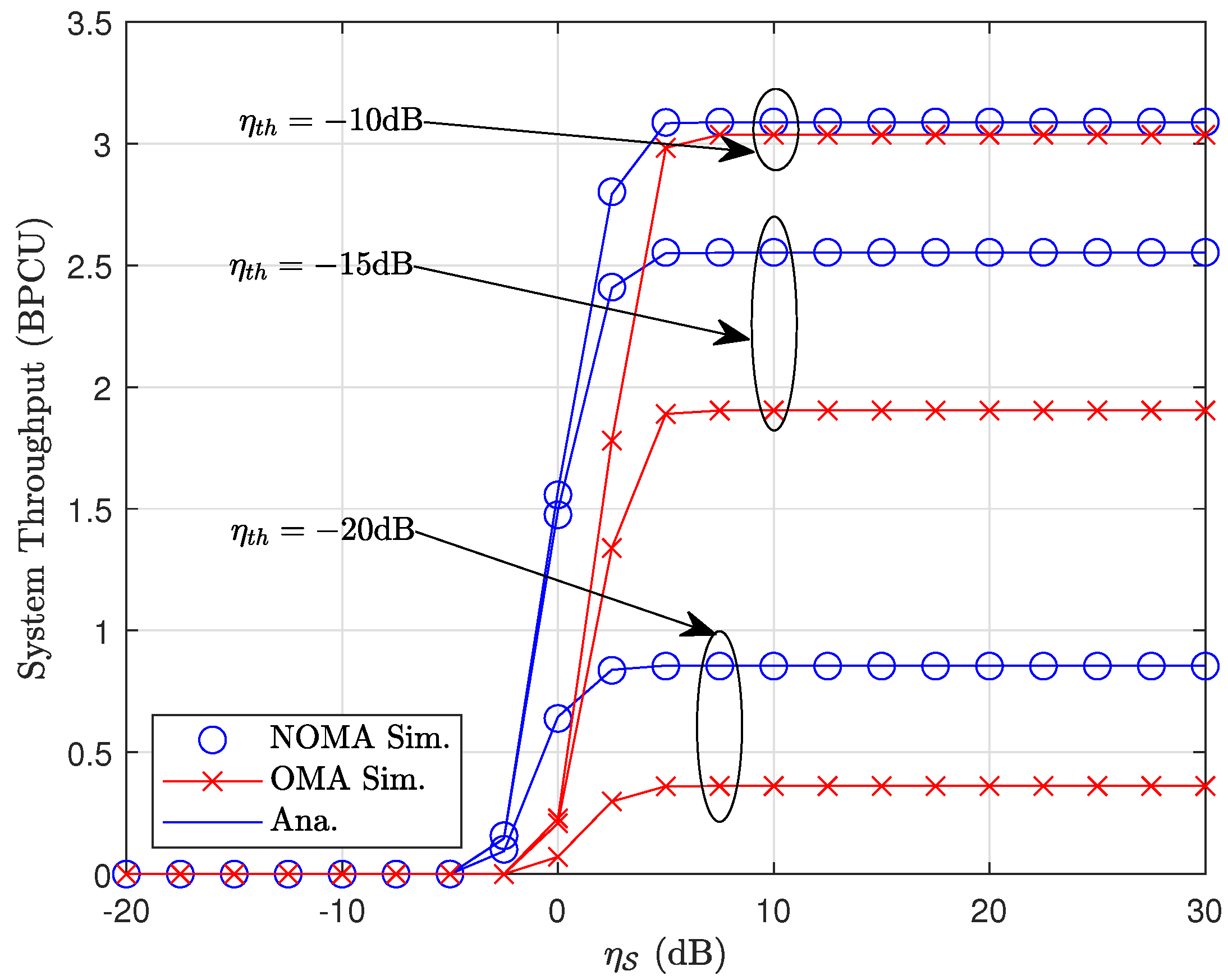Performance Analysis of a Cognitive RIS-NOMA in Wireless Sensor Network
Abstract
:1. Introduction
1.1. Related Work
1.2. Motivation and Contribution
- First, we propose a novel, cognitive RIS-aided NOMA network where a secondary source serves multiple SNs despite interference from the PN.
- Secondly, we analyze the performance of the suggested system in terms of outage probability and system throughput. The approximate closed-form analytical and asymptotic expressions for OP are obtained, providing helpful insights into the proposed system’s configuration.
- Finally, we present a Monte Carlo simulation to validate the accuracy of the theoretical analysis, then we show the discussions about the impacts of (i) the number of reflective elements of the RIS, (ii) the number of PUs, and (iii) the interference from the primary source on the SN. We also present a comparison of the OP and system throughput between the cognitive NOMA system assisted by the RIS and its OMA equivalent.
2. The System Model
3. Performance Analysis
3.1. The Channel Model
3.2. Outage Probability Analysis
3.3. Outage Probability Floor Analysis
3.4. Throughput Analysis
4. Numerical Result and Discussion
5. Conclusions
Author Contributions
Funding
Institutional Review Board Statement
Informed Consent Statement
Data Availability Statement
Conflicts of Interest
References
- Basar, E.; Di Renzo, M.; De Rosny, J.; Debbah, M.; Alouini, M.S.; Zhang, R. Wireless Communications Through Reconfigurable Intelligent Surfaces. IEEE Access 2019, 7, 116753–116773. [Google Scholar] [CrossRef]
- Le, A.T.; Nguyen, T.N.; Tu, L.T.; Tran, T.P.; Duy, T.T.; Voznak, M.; Ding, Z. Performance Analysis of RIS-Assisted Ambient Backscatter Communication Systems. IEEE Wirel. Commun. Lett. 2024, 13, 791–795. [Google Scholar] [CrossRef]
- Vu, T.H.; Nguyen, T.V.; Costa, D.B.D.; Kim, S. Intelligent Reflecting Surface-Aided Short-Packet Non-Orthogonal Multiple Access Systems. IEEE Trans. Veh. Technol. 2022, 71, 4500–4505. [Google Scholar] [CrossRef]
- Nguyen, T.N.; Vinh, N.V.; Nguyen, B.C.; Minh, B.V. On performance of RIS-aided bidirectional full-duplex systems with combining of imperfect conditions. Wirel. Netw. 2023, 30, 649–660. [Google Scholar] [CrossRef]
- Tran, P.T.; Nguyen, B.C.; Hoang, T.M.; Nguyen, T.N. On Performance of Low-Power Wide-Area Networks with the Combining of Reconfigurable Intelligent Surfaces and Relay. IEEE Trans. Mob. Comput. 2023, 22, 6086–6096. [Google Scholar] [CrossRef]
- Di Renzo, M.; Ntontin, K.; Song, J.; Danufane, F.H.; Qian, X.; Lazarakis, F.; De Rosny, J.; Phan-Huy, D.T.; Simeone, O.; Zhang, R.; et al. Reconfigurable Intelligent Surfaces vs. Relaying: Differences, Similarities, and Performance Comparison. IEEE Open J. Commun. Soc. 2020, 1, 798–807. [Google Scholar] [CrossRef]
- Kilinc, F.; Yildirim, I.; Basar, E. Physical Channel Modeling for RIS-Empowered Wireless Networks in Sub-6 GHz Bands: (Invited Paper). In Proceedings of the 2021 55th Asilomar Conference on Signals, Systems, and Computers, Pacific Grove, CA, USA, 31 October–3 November 2021; pp. 704–708. [Google Scholar] [CrossRef]
- Tasci, R.A.; Kilinc, F.; Basar, E.; Alexandropoulos, G.C. A New RIS Architecture with a Single Power Amplifier: Energy Efficiency and Error Performance Analysis. IEEE Access 2022, 10, 44804–44815. [Google Scholar] [CrossRef]
- Tasolamprou, A.C.; Pitilakis, A.; Abadal, S.; Tsilipakos, O.; Timoneda, X.; Taghvaee, H.; Sajjad Mirmoosa, M.; Liu, F.; Liaskos, C.; Tsioliaridou, A.; et al. Exploration of Intercell Wireless Millimeter-Wave Communication in the Landscape of Intelligent Metasurfaces. IEEE Access 2019, 7, 122931–122948. [Google Scholar] [CrossRef]
- Mu, X.; Liu, Y.; Guo, L.; Lin, J.; Al-Dhahir, N. Exploiting Intelligent Reflecting Surfaces in NOMA Networks: Joint Beamforming Optimization. IEEE Trans. Wirel. Commun. 2020, 19, 6884–6898. [Google Scholar] [CrossRef]
- Subrt, L.; Pechac, P. Intelligent walls as autonomous parts of smart indoor environments. Iet Commun. 2012, 6, 1004–1010. [Google Scholar] [CrossRef]
- Arzykulov, S.; Nauryzbayev, G.; Hashmi, M.S.; Eltawil, A.M.; Rabie, K.M.; Seilov, S. Hardware- and Interference-Limited Cognitive IoT Relaying NOMA Networks with Imperfect SIC Over Generalized Non-Homogeneous Fading Channels. IEEE Access 2020, 8, 72942–72956. [Google Scholar] [CrossRef]
- Nguyen, T.L.; Do, D.T. Performance Analysis of Downlink Non-Orthogonal Multiple Access under Imperfect CSI in Dense Network: A Stochastic Geometry Approach. Adv. Electr. Electron. Eng. 2020, 18, 228–234. [Google Scholar] [CrossRef]
- Do, D.T.; Le, A.T.; Lee, B.M. NOMA in Cooperative Underlay Cognitive Radio Networks Under Imperfect SIC. IEEE Access 2020, 8, 86180–86195. [Google Scholar] [CrossRef]
- Le, A.T.; Tran, D.H.; Le, C.B.; Tin, P.T.; Nguyen, T.N.; Ding, Z.; Poor, H.V.; Voznak, M. Power Beacon and NOMA-Assisted Cooperative IoT Networks with Co-Channel Interference: Performance Analysis and Deep Learning Evaluation. IEEE Trans. Mob. Comput. 2023, 23, 7270–7283. [Google Scholar] [CrossRef]
- Nguyen, T.N.; Voznak, M.; Nguyen, B.C.; Hoang, T.M.; Minh, B.V.; Tran, P.T. Improving the Capacity of NOMA Network using Multiple Aerial Intelligent Reflecting Surfaces. IEEE Access 2023, 11, 107958–107971. [Google Scholar]
- Tu, L.T.; Phan, V.D.; Nguyen, T.N.; Tran, P.T.; Duy, T.T.; Nguyen, Q.S.; Nguyen, N.T.; Voznak, M. Performance analysis of multihop full-duplex NOMA systems with imperfect interference cancellation and near-field path-loss. Sensors 2023, 23, 524. [Google Scholar] [CrossRef] [PubMed]
- Zhang, Z.; Sun, H.; Hu, R.Q. Downlink and Uplink Non-Orthogonal Multiple Access in a Dense Wireless Network. IEEE J. Sel. Areas Commun. 2017, 35, 2771–2784. [Google Scholar] [CrossRef]
- Phu, T.T.; Tran, T.D.; Voznak, M. Security-reliability analysis of noma-based multi-hop relay networks in presence of an active eavesdropper with imperfect eavesdropping CSI. Adv. Electr. Electron. Eng. 2017, 15, 591–597. [Google Scholar] [CrossRef]
- Nguyen, N.T.; Nguyen, H.N.; Nguyen, N.L.; Le, A.T.; Nguyen, T.N.; Voznak, M. Performance Analysis of NOMA-Based Hybrid Satellite-Terrestrial Relay System Using mmWave Technology. IEEE Access 2023, 11, 10696–10707. [Google Scholar] [CrossRef]
- Tu, L.T.; Nguyen, T.N.; Duy, T.T.; Tran, P.T.; Voznak, M.; Aravanis, A.I. Broadcasting in cognitive radio networks: A fountain codes approach. IEEE Trans. Veh. Technol. 2022, 71, 11289–11294. [Google Scholar] [CrossRef]
- Zhang, L.; Xiao, M.; Wu, G.; Alam, M.; Liang, Y.C.; Li, S. A Survey of Advanced Techniques for Spectrum Sharing in 5G Networks. IEEE Wirel. Commun. 2017, 24, 44–51. [Google Scholar] [CrossRef]
- Tran, T.N.; Do, D.T.; Voznak, M. On outage probability and throughput performance of cognitive radio inspired NOMA relay system. Adv. Electr. Electron. Eng. 2018, 16, 501–512. [Google Scholar] [CrossRef]
- Nguyen, H.; Nguyen, T.N.; Minh, B.V.; Pham, T.H.T.; Le, A.T.; Voznak, M. Security-Reliability Analysis in CR-NOMA IoT Network Under I/Q Imbalance. IEEE Access 2023, 11, 119045–119056. [Google Scholar] [CrossRef]
- Lv, L.; Chen, J.; Ni, Q.; Ding, Z.; Jiang, H. Cognitive Non-Orthogonal Multiple Access with Cooperative Relaying: A New Wireless Frontier for 5G Spectrum Sharing. IEEE Commun. Mag. 2018, 56, 188–195. [Google Scholar] [CrossRef]
- Zhou, F.; Wu, Y.; Liang, Y.C.; Li, Z.; Wang, Y.; Wong, K.K. State of the Art, Taxonomy, and Open Issues on Cognitive Radio Networks with NOMA. IEEE Wirel. Commun. 2018, 25, 100–108. [Google Scholar] [CrossRef]
- Diamanti, M.; Tsiropoulou, E.E.; Papavassiliou, S. The Joint Power of NOMA and Reconfigurable Intelligent Surfaces in SWIPT Networks. In Proceedings of the 2021 IEEE 22nd International Workshop on Signal Processing Advances in Wireless Communications (SPAWC), Lucca, Italy, 27–30 September 2021; pp. 621–625. [Google Scholar] [CrossRef]
- Arslan, E.; Kilinc, F.; Arzykulov, S.; Dogukan, A.T.; Celik, A.; Basar, E.; Eltawil, A.M. Reconfigurable Intelligent Surface Enabled Over-the-Air Uplink NOMA. IEEE Trans. Green Commun. Netw. 2023, 7, 814–826. [Google Scholar] [CrossRef]
- Kilinc, F.; Tasci, R.A.; Celik, A.; Abdallah, A.; Eltawil, A.M.; Basar, E. RIS-Assisted Grant-Free NOMA: User Pairing, RIS Assignment, and Phase Shift Alignment. IEEE Trans. Cogn. Commun. Netw. 2023, 9, 1257–1270. [Google Scholar] [CrossRef]
- Yue, X.; Liu, Y. Performance Analysis of Intelligent Reflecting Surface Assisted NOMA Networks. IEEE Trans. Wirel. Commun. 2022, 21, 2623–2636. [Google Scholar] [CrossRef]
- Zuo, J.; Liu, Y.; Qin, Z.; Al-Dhahir, N. Resource Allocation in Intelligent Reflecting Surface Assisted NOMA Systems. IEEE Trans. Commun. 2020, 68, 7170–7183. [Google Scholar] [CrossRef]
- Ding, Z.; Vincent Poor, H. A Simple Design of IRS-NOMA Transmission. IEEE Commun. Lett. 2020, 24, 1119–1123. [Google Scholar] [CrossRef]
- Hou, T.; Liu, Y.; Song, Z.; Sun, X.; Chen, Y.; Hanzo, L. Reconfigurable Intelligent Surface Aided NOMA Networks. IEEE J. Sel. Areas Commun. 2020, 38, 2575–2588. [Google Scholar] [CrossRef]
- Cheng, Y.; Li, K.H.; Liu, Y.; Teh, K.C.; Vincent Poor, H. Downlink and Uplink Intelligent Reflecting Surface Aided Networks: NOMA and OMA. IEEE Trans. Wirel. Commun. 2021, 20, 3988–4000. [Google Scholar] [CrossRef]
- Zhang, L.; Wang, Y.; Tao, W.; Jia, Z.; Song, T.; Pan, C. Intelligent Reflecting Surface Aided MIMO Cognitive Radio Systems. IEEE Trans. Veh. Technol. 2020, 69, 11445–11457. [Google Scholar] [CrossRef]
- Yuan, J.; Liang, Y.C.; Joung, J.; Feng, G.; Larsson, E.G. Intelligent Reflecting Surface-Assisted Cognitive Radio System. IEEE Trans. Commun. 2021, 69, 675–687. [Google Scholar] [CrossRef]
- Jiang, W.; Zhang, Y.; Zhao, J.; Xiong, Z.; Ding, Z. Joint Transmit Precoding and Reflect Beamforming Design for IRS-Assisted MIMO Cognitive Radio Systems. IEEE Trans. Wirel. Commun. 2022, 21, 3617–3631. [Google Scholar] [CrossRef]
- Zhang, L.; Pan, C.; Wang, Y.; Ren, H.; Wang, K. Robust Beamforming Design for Intelligent Reflecting Surface Aided Cognitive Radio Systems with Imperfect Cascaded CSI. IEEE Trans. Cogn. Commun. Netw. 2022, 8, 186–201. [Google Scholar] [CrossRef]
- Dong, L.; Wang, H.M.; Xiao, H. Secure Cognitive Radio Communication via Intelligent Reflecting Surface. IEEE Trans. Commun. 2021, 69, 4678–4690. [Google Scholar] [CrossRef]
- Wu, X.; Ma, J.; Xing, Z.; Gu, C.; Xue, X.; Zeng, X. Secure and Energy Efficient Transmission for IRS-Assisted Cognitive Radio Networks. IEEE Trans. Cogn. Commun. Netw. 2022, 8, 170–185. [Google Scholar] [CrossRef]
- Xu, D.; Yu, X.; Sun, Y.; Ng, D.W.K.; Schober, R. Resource Allocation for IRS-Assisted Full-Duplex Cognitive Radio Systems. IEEE Trans. Commun. 2020, 68, 7376–7394. [Google Scholar] [CrossRef]
- Vu, T.H.; Nguyen, T.V.; Costa, D.B.d.; Kim, S. Reconfigurable Intelligent Surface-Aided Cognitive NOMA Networks: Performance Analysis and Deep Learning Evaluation. IEEE Trans. Wirel. Commun. 2022, 21, 10662–10677. [Google Scholar] [CrossRef]
- Guo, K.; Liu, R.; Li, X.; Yang, L.; An, K.; Huang, Y. Outage Performance of RIS-Assisted Cognitive Non-Terrestrial Network with NOMA. IEEE Trans. Veh. Technol. 2024, 73, 5953–5958. [Google Scholar] [CrossRef]
- Arzykulov, S.; Tsiftsis, T.A.; Nauryzbayev, G.; Abdallah, M. Outage Performance of Cooperative Underlay CR-NOMA with Imperfect CSI. IEEE Commun. Lett. 2019, 23, 176–179. [Google Scholar] [CrossRef]
- Zhao, W.; Wang, G.; Atapattu, S.; Tsiftsis, T.A.; Tellambura, C. Is Backscatter Link Stronger than Direct Link in Reconfigurable Intelligent Surface-Assisted System? IEEE Commun. Lett. 2020, 24, 1342–1346. [Google Scholar] [CrossRef]
- Gradshteyn, I.S.; Ryzhik, I.M. Table of Integrals, Series, and Products; Academic Press: Cambridge, MA, USA, 2014. [Google Scholar]
- Do, T.N.; Kaddoum, G.; Nguyen, T.L.; da Costa, D.B.; Haas, Z.J. Multi-RIS-Aided Wireless Systems: Statistical Characterization and Performance Analysis. IEEE Trans. Commun. 2021, 69, 8641–8658. [Google Scholar] [CrossRef]
- Zhang, J.; Pan, G.; Xie, Y. Secrecy Analysis of Wireless-Powered Multi-Antenna Relaying System with Nonlinear Energy Harvesters and Imperfect CSI. IEEE Trans. Green Commun. Netw. 2018, 2, 460–470. [Google Scholar] [CrossRef]
- Abramowitz, M.; Stegun, I.A. Handbook of Mathematical Functions with Formulas, Graphs, and Mathematical Tables; US Government Printing Office: Washington, DC, USA, 1968; Volume 55.







| Parameter | Value |
|---|---|
| Number of secondary users | |
| Number of primary users | |
| Number of reflective elements | |
| Power allocation | , and |
| Scaling coefficient | |
| Target rate | , , [BPCU] |
| Maximum interference level | [dB] |
| Pass loss exponent | |
| Distance | [m], [m], [m], [m], [m], and [m] |
Disclaimer/Publisher’s Note: The statements, opinions and data contained in all publications are solely those of the individual author(s) and contributor(s) and not of MDPI and/or the editor(s). MDPI and/or the editor(s) disclaim responsibility for any injury to people or property resulting from any ideas, methods, instructions or products referred to in the content. |
© 2024 by the authors. Licensee MDPI, Basel, Switzerland. This article is an open access article distributed under the terms and conditions of the Creative Commons Attribution (CC BY) license (https://creativecommons.org/licenses/by/4.0/).
Share and Cite
Thien, H.T.; Le, A.-T.; Minh, B.V.; Rejfek, L.; Koo, I. Performance Analysis of a Cognitive RIS-NOMA in Wireless Sensor Network. Appl. Sci. 2024, 14, 5865. https://doi.org/10.3390/app14135865
Thien HT, Le A-T, Minh BV, Rejfek L, Koo I. Performance Analysis of a Cognitive RIS-NOMA in Wireless Sensor Network. Applied Sciences. 2024; 14(13):5865. https://doi.org/10.3390/app14135865
Chicago/Turabian StyleThien, Huynh Thanh, Anh-Tu Le, Bui Vu Minh, Lubos Rejfek, and Insoo Koo. 2024. "Performance Analysis of a Cognitive RIS-NOMA in Wireless Sensor Network" Applied Sciences 14, no. 13: 5865. https://doi.org/10.3390/app14135865
APA StyleThien, H. T., Le, A.-T., Minh, B. V., Rejfek, L., & Koo, I. (2024). Performance Analysis of a Cognitive RIS-NOMA in Wireless Sensor Network. Applied Sciences, 14(13), 5865. https://doi.org/10.3390/app14135865







